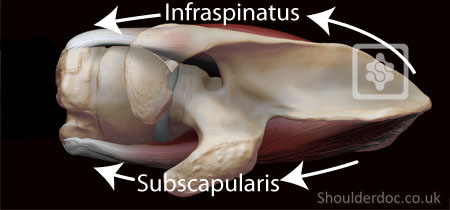Tendon Transfer Procedures
for massive rotator cuff tears
Tendon transfer is a surgical procedure by which a tendon and it's muscle (muscle-tendon unit) is moved from one location to another.
The muscle-tendon unit is transferred in order to substitute the lost function (movement and stability) when repairs of failed muscle is impossible.
In the massive rotator cuff tear, which is not reparable, good results can be obtained with regional tendon transfers. However, the surgeon has to understand the biomechanical principles involved and to perform meticulous surgical technique and rehabilitation. Tendon transfer surgery is a more extensive undertaking than direct rotator cuff repairs. It is often a 'salvage procedure' when direct repairs have failed or are impossible to perform due to the size of the tear or poor muscle and tendon quality. Tendon transfers are less commonly performed and not routinely done by most surgeons. They are generally done by more specialised surgeons with an interest, training and experience in tendon transfer surgery.
Indications:
Tendon transfers are only beneficial for limited indications and thus not all patients with massive rotator cuff repairs are suitable for the surgery. There are numerous requirements before determining whether this would be suitable for an individual. These include:
1. An active patient with functional loss of strength and pain related to the muscle loss.
2. A mobile shoulder joint with no arthritis
3. Good strength of the opposing muscle forces (force couple / antagonist)
4. Good cross-sectional area and bulk of the muscle-tendon unit to be transferred and adequate excursion.
5. The bone quality to hold the fixation
6. Patient compliance and patience with the extensive and prolonged period of rehabilitation.
Force couple between subscapularis at the front and infraspinatus at the back of the shoulder joint:

Before tendon transfer is discussed, many other less invasive treatment options are performed. This includes physiotherapy (particularly deltoid rehabilitation programme), arthroscopic procedures, such as partial repairs or debridement procedures and lifestyle alterations.
Results:
In the appropriate cases, tendon transfers can be extremely beneficial, improving pain significantly and improving muscle strength and function by about 70-80%. Please note, that 100% recovery of strength and complete normal function is unlikely. One can expect an improvement, but not necessarily complete normality.
Complications:
As this is large, open surgery the surgical risks and complications are also higher than standard rotator cuff repairs. These include infection, post-operative stiffness, nerve injuries (which can be significant, although rare) and failure of the transfer.
Common Tendon Transfers for rotator cuff deficiency:
- Pectoralis Major transfer for subscapularis failure
- Latissimus Dorsi transfer for posterior cuff failure (infraspinatus and teres minor)
Also See:


